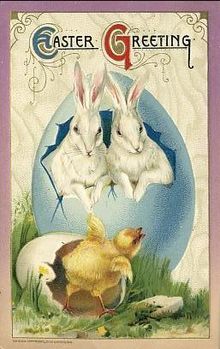
© 2010 Gwen Dewar, Ph.D., all rights reserved
Do you remember when you stopped believing in the Easter Bunny? Santa Claus?
If you grew up speaking English (or any of the Germanic languages), these fantasy characters probably played a role in your early childhood.
A positive role? I’ll bet most of us would say yes.
But some parents worry about the implications of misleading children. These are lies, after all.
Perhaps, when kids discover the truth, they will feel their parents have betrayed them.
In addition, some parents are concerned about critical thinking.
In a single night, a rabbit delivers millions of gifts to children around the world. Asking kids to accept this might seem like an invitation to be credulous and irrational.
So it’s interesting to consider the research. Overall, it’s pretty reassuring.

As you might expect, kids believe in Santa Claus or the Easter Bunny as a function of age.
Kids are also more likely to believe if their parents encourage them to do so (Prentice et al 1978; Anderson and Prentice 1994).
But it’s not clear that these beliefs are a sign of greater gullibility or even a greater interest in fantasy.
In one study, researchers found that a belief in Santa or the Easter Bunny was unrelated to other measures of a child’s interest in fantasy (Prentice et al 1978).
And a recent series of experiments conducted at Harvard found that kids make important distinctions between beliefs in folkloric, fantasy characters and beliefs in other unseen, but scientifically-established, entities (Harris et al 2006).
Kids who professed to believe in Santa or the Bunny were nonetheless less certain about it than they were about the existence of oxygen or germs.
Another set of experiments revealed that 4-year olds don’t invoke magical explanations for things that happen in the real world–not unless those things otherwise seem impossible (Rosengren and Hickling 1994).
I’m reminded of anthropologist Dan Sperber, who notes that people are often asked to believe things that are irrational or absurd. For instance, the Bororo of South America assert that they are red macaws.
Do people really believe such things? Not exactly. The very absurdity or implausibility of the ideas forces people to think of them in a special way.
These are mysteries. They can’t be strictly true. So people don’t take them as literal truths (Sperber 1974).
What happens when kids finally penetrate the veil and reject our fantasies?
We might feel a little awkward or wistful. But the kids don’t appear to be heartbroken.

When researchers questioned children who had stopped believing in Santa Claus and the Easter Bunny–a milestone they reached around the age of 7–kids reported feeling pleased.
They had figured it out. They were enlightened now.
It was the parents–not the kids–who reported feeling a bit sad (Anderson and Prentice 1994; Cyr 2002).
And the lying?
Maybe some kids are a bit disturbed about it.
But John Condry’s dissertation research included interviews with hundreds of kids, and none of them reported feeling angry at their parents when they found out the truth about Easter and Christmas (Condry 1987).
Maybe that’s because kids realize the deception is a friendly one. Studies suggest that children as young as 3 understand the kindly “white lie.”
For instance, preschoolers have been presented with badly-drawn sketches and asked to rate them. When the artist was present, the kids said more complementary things.
In other studies, kids have pretended to be happy with gifts they didn’t really like. They’ve told white lies to spare the feelings of people wearing goofy make-up (see Xu et al 2010 for review of all these studies).
So I’m betting that kids can forgive a benign, culturally-sanctioned deception like the Easter Bunny.
And kids obviously enjoy the ideas, even if they no longer believe in them (Cyr 2002)
References: Children, the Easter bunny, and Santa Claus
References
Anderson CJ, Prentice NM. 1994. Encounter with reality: children’s reactions on discovering the Santa Claus myth. Child Psychiatry Hum Dev. 25(2):67-84.
Condry J. 1987. Developmental Differences in Children’s Reasoning about Santa Claus and Other Fantasy Characters.” Diss Cornell U.
Cyr C. 2002. Do reindeer and children know something we don’t? CMAJ 167(12): 1325–1327.
Harris PL, Pasquini ES, Duke S, Asscher JJ, and Pons F. Germs and angels: the role of testimony in young children’s ontology. Dev Sci. 9(1):76-96.
Prentice NM, Manosevitz M, and Hubbs L. 1978. Imaginary figures of early childhood: santa claus, easter bunny, and the tooth fairy. Am J Orthopsychiatry. 48(4):618-28.
Rosengren KS and Hickling AK. 1994. Seeing is believing: Children’s explanations of commonplace, magical, and extraordinary transformations. Child Development 65: 1605-1626.
Xu F, Bao X, Fu G, Talwar V, and Lee K. 2010. Lying and truth-telling in children: From concept to action. 81(2): 581 – 596.
Content last modified 10/10